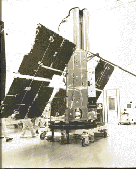|
|
|
|
The Copernicus Satellite (OAO-3)
 opernicus, or Orbiting Astronomical
Observatory 3 (OAO-3) was a collaborative effort between the USA (NASA)
and the UK (SERC).
The main experiment on board was the Princeton University UV telescope,
but it also carried an X-ray astronomy experiment developed by the University
College London/Mullard Space Science Laboratory.
opernicus, or Orbiting Astronomical
Observatory 3 (OAO-3) was a collaborative effort between the USA (NASA)
and the UK (SERC).
The main experiment on board was the Princeton University UV telescope,
but it also carried an X-ray astronomy experiment developed by the University
College London/Mullard Space Science Laboratory.
Mission Characteristics
 Lifetime : 21
August 1972 - February 1981 Lifetime : 21
August 1972 - February 1981
 Energy Range :
0.5 - 10 keV (X-ray experiment only) Energy Range :
0.5 - 10 keV (X-ray experiment only)
 Payload : Payload :
The University College London X-ray Experiment (UCLXE) consisted of 4
co-aligned X-ray detectors
- 3 Wolter type 0 grazing incidence telescopes
with 2 proportional counters (3-9 Å and 6-18 Å)
and a channel photomultiplier at the foci.
(variable FOV from 1 to 12 arcmin)
- 1 proportional counter (1-3 Å) with a simple collimation tube.
(2.5° X 3.5° FOV)
 Science Highlights:
Science Highlights:
- Discovery of several log period pulsars (e.g. X Per).
- Discovery of absorption dips in Cyg X-1.
- Long-term monitoring of pulsars and other bright X-ray binaries.
- Observed rapid intensity variability from Cen A.
 Archive : Raw data from the UCLXE.
Archive : Raw data from the UCLXE.
[About Copernicus] (http://heasarc.gsfc.nasa.gov/docs/copernicus/copernicus_about.html)
[Archive] (http://heasarc.gsfc.nasa.gov/docs/copernicus/archive/copernicus_archive.html)
[Software] (http://heasarc.gsfc.nasa.gov/docs/copernicus/archive/copernicus_software.html)
[Gallery] (http://heasarc.gsfc.nasa.gov/docs/copernicus/copernicus_images.html)
[Publications] (http://heasarc.gsfc.nasa.gov/docs/copernicus/bib/copernicus_biblio.html)
|
|
